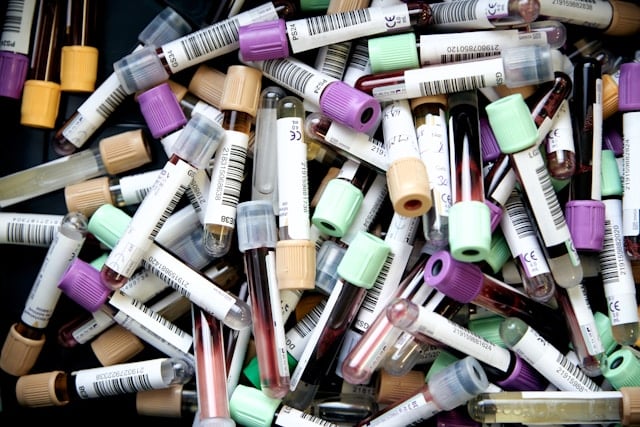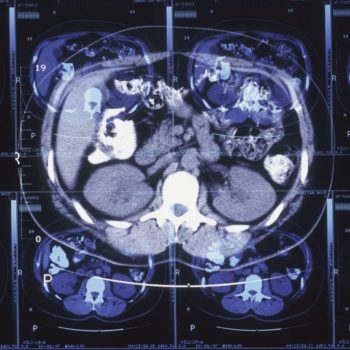Scientists recently published a report showing that soundwaves from ultrasound machines could help make Alzheimer’s drugs more effective by enabling their journey from the bloodstream to the brain.
In the last three years, amyloid plaque-busting drugs Aduhelm (now discontinued) and Leqembi have been approved by the FDA for treating patients in the earliest stages of Alzheimer’s disease. And there are more on the way — donanemab has a good shot at FDA approval as soon as spring of 2024. This first generation of disease-modifying drugs may be the latest, greatest innovation in Alzheimer’s treatment, but they’re not perfect, and here’s one problem: They struggle to cross the blood-brain barrier. So far, these monoclonal antibody drugs are being administered by intravenous infusion, and only a small amount actually makes it to the brain.
The blood-brain barrier is like a fortress wall around the brain, and it’s very selective about what it lets in. While this protects the brain from toxins and infections, it also blockades drugs like monoclonal antibodies.
A recent research article published in the New England Journal of Medicine showcases a potential solution: Infiltrating the blood-brain barrier by blasting soundwaves — called focused ultrasound — that make it easier for Alzheimer’s ant-amyloids to get in. The research is quite new: The study described in the article only involved three patients, and it is the first study to use focused ultrasound in conjunction with an Alzheimer’s drug.
The researchers found that ultrasound sped up plaque removal from the drug Aduhelm. However, the scientists wrote that they need to see more patients to determine whether this technique can make monoclonal antibody anti-amyloids like Aduhelm safer or more effective.
“Focused ultrasound is a non-invasive outpatient procedure for blood-brain barrier opening with great promise for improving drug delivery to the brain,” Dr. Ali Rezai, a neurosurgeon at the Virginia University Rockefeller Neuroscience Institute said in a press release. “The next phase of the clinical trial will begin this year to explore how to further accelerate amyloid-beta removal in a shorter time with focused ultrasound in combination with lecanemab antibody.”
Dr. Sandra Black, a neurologist and professor at the University of Toronto, who was not involved in the study, told Being Patient that the study was a “very clever proof-of-concept” that showed that focused ultrasound combined with an anti-amyloid drug could enhance amyloid clearance.
Black also spoke of personalized ultrasound helmets, being developed to treat a variety of other neurological disorders, like Parkinson’s.
How does focused ultrasound work?
Focused ultrasound involves using high-frequency sound waves humans can’t hear to help open up the blood-brain barrier. Rather than just blasting these soundwaves at the blood-brain barrier, the scientists also injected tiny air bubbles into the blood vessels, which act like guitar amps at a concert and amplify the sound.
When the sound waves hit the bubble, they stretch out and open a temporary passageway within the blood-brain barrier. Black was part of the team that conducted the very first focused ultrasound study on six volunteers with Alzheimer’s disease — at the time, there were no approved anti-amyloid drugs.
“We showed that we could open up the blood-brain barrier safely, and we saw that it led to some reduction in amyloid load,” Black said.
The blood-brain barrier normally loosens and tightens over 24 hours. At night, it becomes looser, allowing toxic plaques like amyloid to be pumped out of the brain. Focused ultrasound helps enhance these functions.
Now, scientists are delivering drugs while the blood-brain barrier is opened, to see if it might help clear beta-amyloid plaques even faster.
What did the study find?
The researchers enrolled three volunteers in their study in the early stages of Alzheimer’s disease. The volunteers received an intravenous infusion of Aduhelm and focused ultrasound once a month for six months.
The scientists only blasted half of each participant’s brain with ultrasound. This way, they could compare the drug on its own to the added effects of ultrasound by comparing plaque clearance across the two halves of the brain.
At the end of these six months, the halves of the brain that received focused ultrasound and Aduhelm showed a lot more clearance of beta-amyloid plaques.
At the follow-up, 30 days after the experiment, two of the three patients showed no cognitive decline. However, since this trial only included three participants and didn’t have an actual control group, the authors noted that it is hard to tell whether focused ultrasound enhances Alzheimer’s treatment.
What does clearing plaques faster mean for patients?
Will clearing these beta-amyloid plaques from the brain at a faster pace prove a more effective treatment for Alzheimer’s? Black said scientists don’t have enough information yet about these treatments to say for sure.
Kullervo Hynynen, senior scientist at Sunnybrook Health Sciences Center who studies focused ultrasound but wasn’t involved in the study, wrote that “additional studies are needed to establish long-term safety and efficacy.”
There are still questions over whether removing beta-amyloid plaques is that important or helpful. Although data shows that Leqembi is effective in clearing a lot of the beta-amyloid plaques in patients’ brains, the amount by which the drug actually slows cognitive decline is small — debatably even unnoticeable. Other trials are underway to see if removing these plaques before symptoms might have a protective effect.
In addition to clearing beta-amyloid plaques, other protein deposits like tau or TDP-43 build up in the brains of people with Alzheimer’s, so researchers agree that it might take more than clearing amyloid to slow down the disease even more.
Would adding another potentially expensive technology — focused ultrasound, — into infusion clinics make it even more difficult to access new Alzheimer’s drugs?
Health centers in the U.S. are straining to deliver Leqembi prescriptions and infusions because of a lack of trained personnel, and patients who want the drug report experiencing long waitlists. The good news: Black doesn’t think that focused ultrasound is too far off in the future.
Researchers are developing focused ultrasound devices that could easily fit in an infusion center and wouldn’t require additional staff, she said. Some are so small, they’re portable: Researchers at Sunnybrook Hospital in Toronto, Canada are developing personalized helmets that could deliver focused ultrasound to treat various conditions.





How does one get into trial of focused ultrasound?
My husband would love to be in a study group.
Hi Carolene, here’s a list of five studies currently recruiting which you can find through clinicaltrials.gov, the country’s official trial resgistry: https://www.clinicaltrials.gov/search?term=focused%20ultrasound&aggFilters=status:rec&cond=alzheimer%27s . We know it can be confusing to navigate and we’d love to help! If you have questions, email us at info@beingpatient.com.
Just interested to know of any new information available to help me.
Hi Kathryn, thank you for being here. If there’s any specific questions or topics you’d like to learn more about, feel free to reach out to us at info@beingpatient.com.